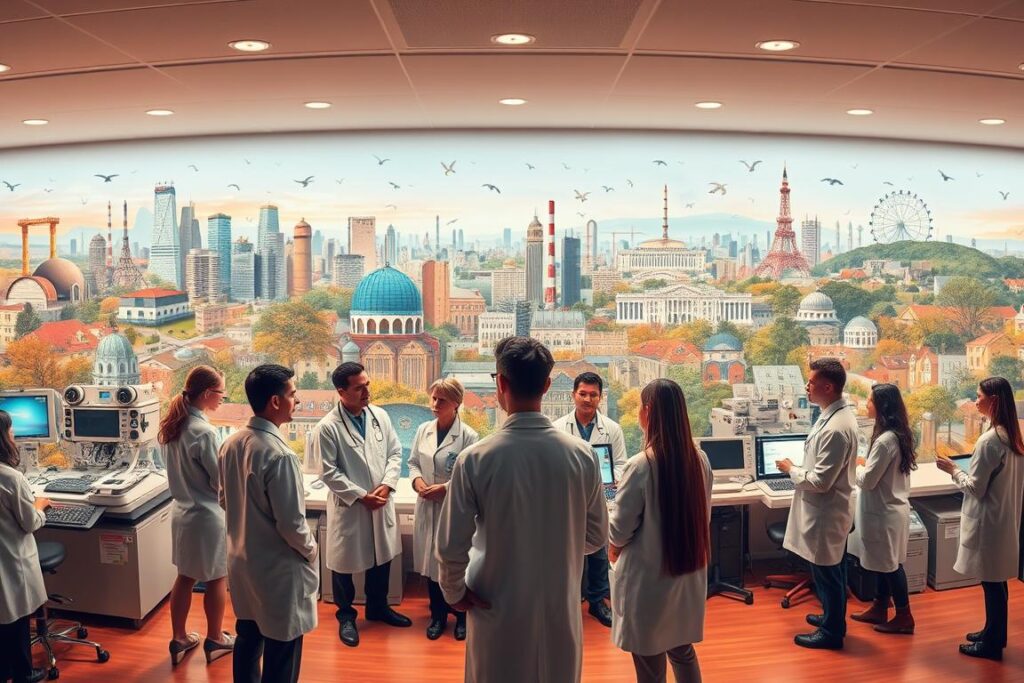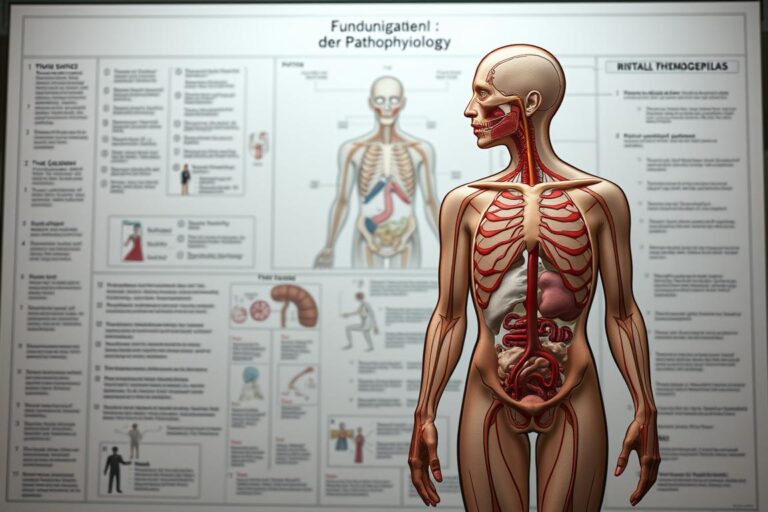European Academy for Clinical Environmental Medicine
Did you know that the certified training for clinical environmental medicine comprises over 160 hours of instruction and that doctors receive 280 training points for this? The European Academy of Clinical Environmental Medicine is a leading institute dedicated to the identification and research of environmental health disorders. Since 2014, the Academy has been offering its training courses in a user-friendly blended learning format, so that participants can access the learning content anytime and anywhere.
The European Academy of Clinical Environmental Medicine also stands out for its comprehensive educational programs aimed at developing new methods for the diagnosis and prevention of environmental health risks. With over 50 international experts as speakers and the course content divided into short learning units of 5 to 20 minutes, the Academy offers its participants an optimal learning environment.
Introduction to environmental medicine
Environmental medicine deals with the complex interactions between human health and environmental factors. It looks at both the causes and preventative measures of diseases caused by environmental factors. The definition of environmental medicine is crucial as it provides the framework for investigation and treatment.
Definition and meaning
The definition of environmental medicine encompasses the examination and treatment of diseases caused by environmental pollution. These are often characterized by chronic diseases and systemic inflammatory reactions. Patients whose health complaints are attributable to various environmental factors find support in clinical environmental medicine. This discipline takes individual vulnerability and susceptibility into account in diagnosis and treatment. Biomonitoring and effect monitoring also play an important role by measuring pollutants and biochemical changes in the organism.
Historical background
The history of environmental medicine is closely linked to the development of public health. Originating from the 19th century hygiene movement, environmental medicine has had a significant impact on health care and disease prevention over the decades. The diagnosis of environmental diseases is often challenging due to the long time lag between exposure and disease manifestation. Consideration of all relevant environmental factors, including toxic, biological and physical stressors, is essential. An important part of the history of environmental medicine is the development of measures to prevent exposure and eliminate major stressors.
Objectives and tasks of the European Academy of Clinical Environmental Medicine
The European Academy of Clinical Environmental Medicine is committed to the identification and research of environmental health disorders. The aim is to gain an in-depth understanding of the causes and mechanisms of such disorders in order to develop precise diagnostic methods and treatment concepts.
Detection and research into health disorders
Detection and research play a central role in clinical environmental medicine. Environmental factors such as toxic substances, allergens, microbial pathogens and physical stresses such as noise and air pollution can have a significant impact on health. In up to 80% of cases, chronic illnesses can be caused by environmental factors, with individual susceptibility playing a key role. Interdisciplinary approaches are often required to recognize these effects. Over 50% of patients require additional clinical tests to make accurate diagnoses.
Treatment and prevention
Another key aspect of the objectives of environmental medicine is treatment and prevention. Here, great emphasis is placed on avoiding exposure, followed by the remediation of the living and working environment. In addition, specific prevention strategies are developed to protect the population from the harmful effects of environmental pollution. Effect monitoring records biochemical changes as indicators of environmental health disorders, using markers such as enzymes and metabolites.
Risk assessment and minimization
Risk assessment and minimization of environmental pollution is crucial for health promotion. Biomonitoring, which includes the analysis of tissue samples, blood, urine and other body fluids to determine pollutant concentrations, plays a central role. In the case of multiple exposures, potentiation effects can occur that go beyond additive summation effects. Genetic dispositions can also have a considerable influence on individual susceptibility to environmental factors. Long-term effects of lipophilic toxins in the low-dose range can be detected, but are often difficult to quantify.
- Detection and investigation of environmental disturbances
- Development and implementation of prevention strategies
- Risk assessment and minimization of environmental pollution
These measures are an integral part of clinical environmental medicine and are based on the objectives of environmental medicine in order to reduce health impairments and improve the quality of life of the population.
| Measure | Description |
|---|---|
| Recognition | Interdisciplinary diagnostics to identify environmental factors |
| Prevention | Development of avoidance and protection strategies |
| Risk assessment | Analysis and minimization of environmental pollution |
| Health promotion | Initiatives to promote healthy lifestyles |
The role of environmental medicine in public health
Environmental medicine plays a central role in public health, promoting both prevention and support for environmental policy. Given the increasing environmental pressures affecting our health, this medical specialty is of critical importance.
Primary prevention
Primary prevention in environmental medicine aims to prevent diseases before they develop. By identifying and reducing environmental factors that can cause health disorders, public health is improved. For example, lipophilic toxins or endocrine disruptors are known for their long-term effects even at low-dose exposures. The implementation of such preventive measures is crucial to stop the increasing incidence of environmental diseases.
Political support
Scientific evidence is the foundation for sound environmental policy. The advisory role of environmental medicine in policy making is essential to promote health policies and measures based on the latest research. The exchange between physicians and policy makers helps to develop effective measures to combat environmental pollution. For example, social health indicators, such as the almost 7.8 million registered severely disabled people in Germany, are included in environmental policy to strengthen preventive measures.
Areas of application and specializations
The fields of application of environmental medicine are diverse and include numerous areas in which environmental factors play a role. In Germany, for example, there is currently only one additional qualification for allergology, whereas most European countries already have a specialist in allergology. The additional qualification requires 18 months of further training, while five years of training is required to become a specialist in allergology. Such harmonization of training is considered essential in order to ensure the quality of allergology training in Germany and to keep pace with European developments.

Another important area of application of environmental medicine is electrosensitivity. The “EMF Guideline” from EUROPAEM, which was adopted on August 9, 2016 and comprises over 50 pages, exists for this purpose. According to the Federal Office for Radiation Protection (BfS), there have been no inquiries from doctors or patients about this guideline to date. The “Bioinitiative Report 2012”, on which the EMF guideline is partly based, shows significant deviations in the risk assessment compared to other scientific organizations. The scientific opinion on the complaints that are subjectively attributed to electromagnetic fields is divided.
Studies, such as those by Dieudonne (2016) and Rubin (2006), suggest that electrosensitivity can have a psychological background and that behavioral therapy can be helpful. Such specializations in environmental medicine require in-depth knowledge of the interactions between environment and health and are crucial for the sound diagnosis and treatment of diseases influenced by environmental factors, such as neurodegenerative diseases, childhood leukemia and cancer.
Linking clinical practice and research
The European Academy of Clinical Environmental Medicine promotes the close connection between clinical practice and clinical research. Such an integrative approach makes it possible to efficiently transfer the latest research findings into practical application and thus directly benefit patients.
Interdisciplinary cooperation
A central aspect of this is interdisciplinary cooperation. This means that experts from different fields such as medicine, biology, chemistry and environmental sciences work together on projects. For example, the Environmental Health Center at Helmholtz Munich and the Institute of Occupational Medicine, Social Medicine and Environmental Medicine at the University of Frankfurt are working together to conduct comprehensive studies on the prevention of environmentally associated diseases.
Research interfaces
The establishment of research interfaces between universities and clinics is another important step. Such interfaces create spaces in which clinical research and practical applications go hand in hand. One example of this is the JANE-2 project, which aims to improve palliative care in oncology throughout Europe. It involves 121 partner institutions from 29 countries and is funded by the EU to the tune of over 40 million euros.
| Institution | Focus | Cooperation |
|---|---|---|
| Environmental Health Center at Helmholtz Munich | Environmental Medical Research | University of Frankfurt |
| EUROPAEM | Curricular training | German and English language courses |
| University of Innsbruck | Occupational and Environmental Medicine | Postgraduate degree programs |
| University of Cologne | Clinical Environmental Medicine | Structural training |
Study programs and further training opportunities
The European Academy of Clinical Environmental Medicine offers a variety of undergraduate and postgraduate environmental medicine programs specifically designed to help professionals deepen their knowledge and skills in the field of environmental medicine. These programs are both academic and practical and cover a wide range of topics.
One of the highlights is the BÄK curriculum “Practical Environmental Medicine” with a total of 100 teaching units (UE). It consists of five modules:
| Module | Teaching units (TU) |
|---|---|
| Module I | 28 LESSONS |
| Module II | 12 UNITS |
| Module III | 24 UNITS |
| Module IV | 24 UNITS |
| Module V | 12 UNITS |
These modules are flexible and can be used separately. However, in order to acquire the entire BÄK curriculum, you must have completed specialist training. The course includes both theoretical and practical components, which are carried out in the form of workshops, case seminars and supervision.
In addition, personal attendance at face-to-face events is important and is checked by means of attendance lists and random checks. The final assessment of learning success is carried out after the entire curriculum and can take place in written or oral form.
In addition to the degree programs in environmental medicine, the Academy also offers continuing education in environmental medicine, which includes eLearning components but should not exceed 20% of the total training. These measures are designed to be carried out in a reasonable period of time to ensure comprehensive and in-depth education.
Important publications and research results
The European Academy of Clinical Environmental Medicine plays a central role in the publication of scientific papers. The Academy regularly publishes important publications that present new findings and research results in the field of environmental medicine and inform the scientific community and practitioners.
Some remarkable statistics underline the importance of this publishing activity:
- The Quality Development in Research and Teaching Committee and the Education and Training Committee complement each other thematically.
- Mean impact factors (mIF) of the fields in the Science Citation Index (SCI) are recommended for subject-specific weighting.
- Quality development in research is used as a decision-making criterion when awarding academic degrees, hiring and appointments.
- Performance-oriented allocation of funds (LOM) is based on indicators of research performance, which have been the subject of intense debate for years.
- On average, the LOM for teaching performance (LOM/teaching) plays a subordinate role compared to the LOM/research.
- The lack of suitable and recognized indicators for the evaluation of teaching performance is identified as a major factor in the imbalance in incentives.
- Subjective student evaluations and pass rates in state examinations are not considered sufficiently valid indicators of teaching performance.
- Experience with various indicators exists, but has not yet been systematically evaluated.
- There is a need for generally accepted methods of performance evaluation in teaching and their implementation in a recognized LOM-capable algorithm.
Particular attention is also being paid to climate-related health risks. According to estimates by the World Health Organization (WHO), up to 250,000 additional deaths per year between 2030 and 2050 could be caused by diseases such as malnutrition, malaria, diarrhoeal diseases and heat stress. These findings flow into scientific publications and reflect the importance of environmental medicine on a global level.
In addition, the Academy’s research examines the differences in the health effects of an average global warming of 1.5 or 2 degrees Celsius and highlights the climate-related risks for different population groups, particularly vulnerable groups such as the elderly, people with pre-existing conditions, low-income groups and children. Primary climate impacts, such as extreme weather events, air pollution and ice melt, are also being researched in order to better understand the health effects and derive preventive measures.
Significant members and their contributions
The members of the Academy have made a decisive contribution to the further development of environmental medicine. A historic milestone was the founding of the German Society for Occupational Medicine on February 3, 1962 in Hamm/Westphalia. It was entered in the Munich register of associations on February 16, 1962 and the first board meeting was held on June 28/29, 1962 in Nuremberg, where important resolutions were passed from 9 p.m. to 1:30 a.m. The first annual scientific conference took place on October 8-9, 1962 in Augsburg and had the topic “Byssinosis”.
Since its foundation, numerous contributions to environmental medicine have been made by important members. By 2012, a total of 51 annual scientific conferences had been held, creating mandatory events for the transfer of knowledge and discussion of new findings in environmental medicine. The establishment of the Franz Koelsch Medal in 1967, which recognizes outstanding achievements in occupational and environmental medicine, deserves special mention.
The specialist journal “Arbeitsmedizin – Sozialmedizin – Arbeitshygiene”, the first issue of which appeared in January 1966, served as another important means of communication for members of the Academy to publish significant research findings and contributions to environmental medicine. In addition, the regular scientific conferences and curricular training in clinical environmental medicine are outstanding examples of the continuous promotion of this discipline.
| Year | Event |
|---|---|
| 1962 | Foundation of the German Society for Occupational Medicine |
| 1966 | First issue of the journal “Arbeitsmedizin – Sozialmedizin – Arbeitshygiene” |
| 1967 | Foundation of the Franz Koelsch Medal |
| 2012 | 51 annual scientific conferences since 1962 |
| 2022 | 60 years of the German Society for Occupational and Environmental Medicine |
Namesakes such as Prof. Dr. med. h.c. E.W. Baader and many others have proved to be essential members of the Academy throughout its history. These outstanding personalities and their contributions to environmental medicine lay the foundation for today’s progress in research and practice and set an example for future generations.
Events and conferences
The European Academy of Clinical Environmental Medicine regularly organizes environmental medicine events and environmental medicine conferences to promote the exchange of the latest research findings and clinical practices. These events offer extensive opportunities for networking and further training.
Annual conferences
One of the most important annual conferences is the 11th Bavarian Congress for the Public Health Service and the 74th Scientific Congress of the BVÖGD, the BZÖG and the DGÖG, which will take place from April 1 to 4, 2025. International conferences such as the ATS 2025 International Conference in San Francisco, which will take place from May 17 to 21, 2025, are also firmly anchored in the calendar.
- Allergo Update 2025 on 7. – March 8 in Mainz
- 19th World Immune Regulation Meeting from March 12 – 15 in Davos
- 65th Congress of the DGP – Pneumology 2025 from April 9 – 12 in Leipzig
- EAACI Congress 2025 from June 13 – 16 in Glasgow
Special seminars
In addition to the large conferences, the Academy also organizes specific seminars. The symposium on process optimization for the care of people with cognitive impairments in hospitals on 9 December 2024 is an example of such specialized environmental medicine events. Another seminar worth highlighting is the 2nd symposium on dementia-sensitive environmental design and architecture on April 25, 2024.
- 18th compact course in pediatric pneumology in Wörlitz on 28. – March 29, 2025
- Symposium “BÄK Curriculum Climate Change and Health 2025” on March 29, 2025 (live online)
- 6th Novel concepts in innate immunity 2025 on June 10-13, 2025 in Tübingen/digital
- 8th World Bronchiectasis Conference in Brisbane on July 14 – 17, 2025
Future prospects for environmental medicine
The future of environmental medicine looks promising as advancing technologies and a growing awareness of environmental health open up new avenues in the prevention and treatment of environmental diseases. Thanks to increasing digitalization and the use of big data, relevant environmental data can be evaluated more efficiently. This enables a more precise determination of environmental factors that could be harmful to health.
Another exciting field for the future of environmental medicine is the development of innovative diagnostic and therapeutic procedures. Advances in the fields of genetics and personalized medicine play a particularly important role here. Individual genetic profiles can provide information on how people react to different environmental factors, enabling tailored prevention and treatment approaches.
Interdisciplinary cooperation will also continue to be important. Projects such as “Didactic Models for Qualification in Occupational Medicine”, which were commissioned by the Federal Institute for Occupational Safety and Health, reflect the trend towards integrating problem- and participant-oriented teaching methods into training. This innovative strength in education can be transferred more directly to clinical practice in order to significantly increase the efficiency of environmental medicine.






